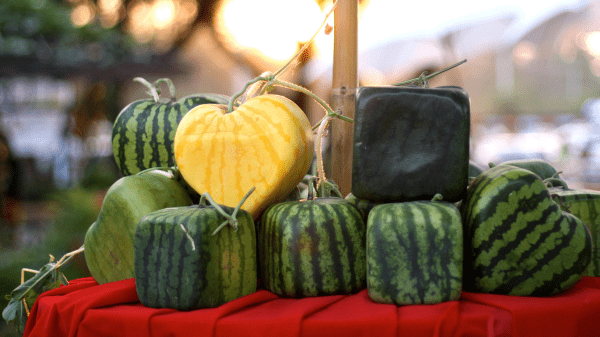Watermelons, however delicious, do not come in the most convenient shapes. The traditional huge oblong watermelon is being challenged by the smaller round type—better suited to present family sizes, but still clumsy for cutting and cubing.
The Japanese would appear to have the answer with square, or rather cubical, watermelons. Zentsuji, on the southerly isle of Shikoku, is the center of production for this novel version of a familiar fruit. (Heart-shaped versions are also available.)

Anyone can see the advantages of this much more pragmatic size for both storage and slicing.
Growing these rectilinear wonders is easy, at least according to some sources: while the fruit is still small, it is placed in a cubical plastic box (clear, of course, to permit light to come through). It reminds me of that French eau de vie that comes with a full-grown pear in the bottle—no doubt from the same technique.
On the surface, the cubical form would appear to be the vanguard of the future. Except for one big caveat: you can’t eat these watermelons. In order to grow them to that shape, growers have to use a specific cultivar with bland and more or less inedible fresh. Furthermore, they’re harvested before they’re ripe.
Consequently, it’s not entirely clear that the backyard gardener armed with a plastic Lucite box will necessarily produce a melon that anybody would want to eat. Commercial production would be even more problematic, except as specialty items, which is what these melons are in Japan.
The Japanese purchase them as gifts and novelties—at prices ranging from $90 to $500 apiece. Whether the typical American would be delighted to receive an inedible cube of vegetative matter, however innovative, is another question.
All the same, there may be some potential for innovation here. A cubical melon has enormous advantages for storage and shipping—both in transit and in the home. I could see that a clever plant scientist could devise a cultivar that not only fits into that shape but tastes delicious. Of course, today’s preferences demand that it would also have to be seedless.



